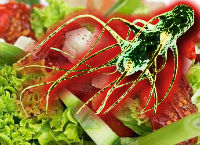Organism Details:
Shape and Size
1 x 3-4 µm, Rod-Shaped.
Genome Information
Bacillus cereus AH187 (GI:217957581) has a circular DNA chromosome of 5269030 bp was completely sequenced using the shotgun sequencing method. The genome structure of B. cereus consists of 5,269 genes and 5,134 coding proteins with no Pseudo Genes, rRNAs: 39 ( 5S, 16S, 23S ), tRNAs: 96. The GC content of Bacillus cereus is about 35.4%.
Food Source
decaying organic matter,
Vegetables,
Fried rice,
Spices,
Dried,
Foods,
Milk, Dairy products,
Vegetable dishes,
Sauces,
Fomites,
Mashed Potato Medium ,
Pasta,
Milk, Ready-to-eat (RTE) food, Salad.
Pathological Factor
B.Cereus produce three differnet enterotoxin of protein nature: 1)Haemolysin BL (Hbl): Responsible for dermonecrotic and vascular permeability activities, causes fluid accumulation which finally leads to endopathalmitis. 2)Non hemolytic enterotoxin (Nhe): Pore forming Toxin, responsible for food associated Diarrhoeal outbreak. 3)Cytotoxin K (CytK): Associated with sever outbreak of Foodborn illness.
The main virulence factor of B. cereus is HBL which is made of the three proteins B, L1, and L2. Other factors are Emetic Toxin Cereulide(Ces) small cyclic a ring structure (dodecadepsipeptide) which consists of four amino acids repeating three times and oxy acids and has a molecular mass of 1.2KDa. Cereulide peptide toxin associated with emetic syndrome is more resistant to acidic conditions and remains active at 121°C. Enterotoxin is responsible for causing 'Diarrhoeal Syndrom' followed by abdominal pain and watery diarrhoea while Emetic disease is caused by a small cyclic peptide followed by nausea and vomiting.
Virulence factors associated with non- gastrointestinal infections include hemolysins and phospholipase C. Hemolysin III causes erythrocyte lysis. Phospholipase C causes tissue damage by stimulating degranulation of human neutrophil and breaks down the subepithelial matrix affecting the healing of tissues in infections.
Disease
B. cereus is commonly known to cause food-borne intoxications. It has been reported to cause local and systemic infections, as an opportunistic pathogen, mainly infect immunocompromised patients, newborns. B. cereus can cause ocular infections such as keratitis, endophthalmitis and panophthal. The main virulence factor in B. Cereus endophthalmitis is HBL which can result in the detachment of the retina and blindness. In addition, B. cereus can cause gangrene, bovine mastitis, pyogenic infections, cellulitis, infant death, septic meningitis, periodontal disease, lung abscesses, and endocarditis. However, these infections are less common but generally causes: Diarrhoeal syndrome, Emetic syndrome, Eye-infection, Urinary Tract Infections, Puerperal sepsis, Pulmonar Disease.
Affected Body Organs
Blood and bronchoalveolar lavage, Central nervous system
|








